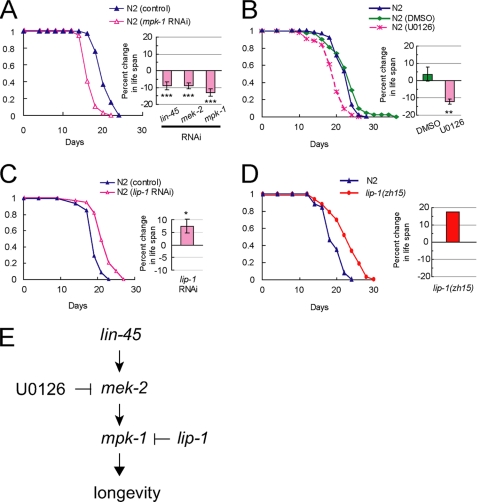FIGURE 1.
C. elegans ERK-MAPK cascade functions to extend life span. A, effect of RNAi of mpk-1 (left and right), lin-45 (right), or mek-2 (right) on N2 life span. Each life span curve presented here is the result of more than 40 worms examined. Bars (right) show percent changes in life span of RNAi-treated worms compared with that treated with control RNAi. ***, p < 0.001. (For statistical analysis, see Table 1.) B, effect of the MEK inhibitor U0126 on N2 life span. Each life span curve presented here is the result of more than 40 worms examined. Bars (right) show percent changes in life span of N2 worms treated with DMSO (N2 (DMSO)) or U0126 (N2 (U0126)) compared with worms on the plate containing no agents. **, p < 0.01. (For statistical analysis, see Table 1.) C, effect of RNAi of lip-1 on N2 life span. Each life span curve presented here is the result of more than 40 worms examined. Bars (right) show percent changes in life span of RNAi-treated worms compared with that treated with control RNAi. *, p < 0.05. (For statistical analysis, see Table 1.) D, effect of lip-1 mutation on life span of worms. Each life span curve presented here is the result of more than 30 worms examined. Bars (right) show percent changes in life span of lip-1(zh15) compared with that of N2. (For statistical analysis, see Table 1.) E, three genes, lin-45 (Raf1), mek-2 (MEK1/2), and mpk-1 (ERK1/2), constitute the C. elegans ERK-MAPK cascade that promotes longevity. U0126 inhibits MEK-2. LIP-1 (MKP3), a dual specificity phosphatase, inactivates MPK-1.

